An Extremely Late Photo-Blog of Tallinn; Extremely Late Part II
So this has quite possibly been one of the biggest gaps in blogging history, and between two parts of the same story, nonetheless... my deepest apologies. In my defense, we've had visitors, followed by visitors, followed by dog sitting, followed by dog sitting, and now more visitors. All great fun, naturally, but time-consuming. Then this was followed by writing up a delightful blog... which I then accidentally deleted. Ugh. Consequently, I couldn't face blogging again until now.
So, where did we leave off? I believe with stray cats being thrown in the town well. Let us depart, then, for the other side of Town Hall Square.
This is the Holy Spirit Church, whose baroque clock is still a common meeting place.
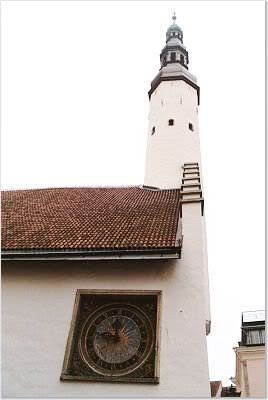
and here is a picture I've borrowed for a close-up of the clock. Despite the weathering of the ages, it's still quite colorful.

Close by is the original House of the Brotherhood of Blackheads, with its ornate front door. The bachelors-only trade organization was founded in Tallinn around 1400. You may recall the House of Blackheads building in Riga.

Due to being set on a granite cliff, Tallinn's old town is hilly; combined with its cobblestone streets, walking through town is a little bit of a challenge, but well worth it. Here is the view behind you as you walk uphill to Toompea from the Lower Town center.

At the top of the hill, the highest point in Toompea, sits the Alexander Nevsky Cathedral. The cathedral was built during the late 19th century, one of Russia's multiple occupations of Estonia. Between occupations there were plans to take it down, but now it has been restored and draws many tourists.

Facing the cathedral is the pink Riigikogu, or Estonian Parliament, an addition to the 13th century Toompea Castle from the 1920s.
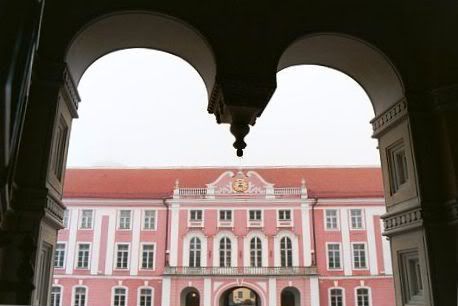
Behind the cathedral, as well as a nice view of the more modern section of Tallinn, you see the walls of the Lower Town below, most notably Kiek in de Kök, one of a few remaining defense bastions. (There were originally 66; 20 are now left.) Kiek in de Kök means "Peek in the Kitchen;" they say the soldiers on guard there could see into the kitchens of the houses in the Lower Town. Its walls are over 13 feet thick. It now houses a museum and has some great views from the top, into kitchens or otherwise.
Here is the town wall; the tower in back is Kiek in de Kök.

a view of the Alexander Nevsky Cathedral from the tower...
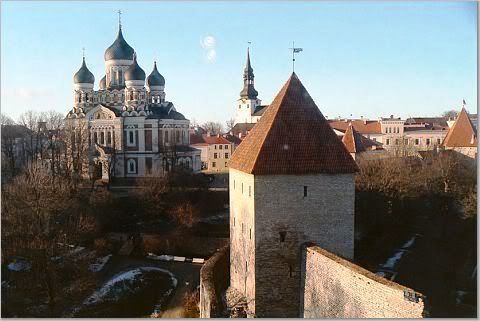
the Estonian flag, flying from the Pikk Hermann tower of Toompea Castle...

views over town...
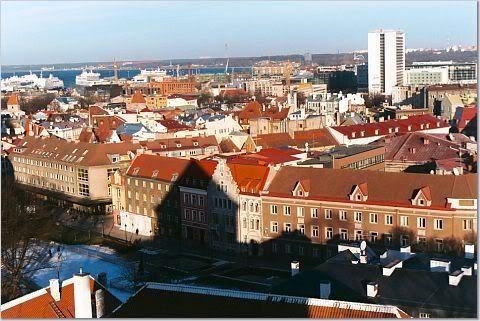
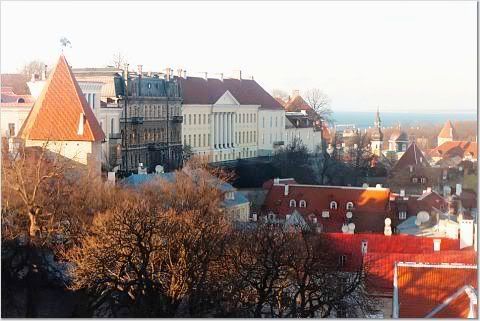
and a view of St. Nicholas cathedral, which we will get a closer look at soon.
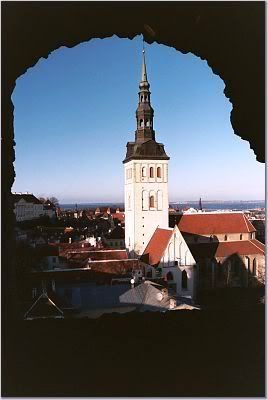
St. Nicholas' church, or Niguliste Kirik in Estonian, was badly damaged during WWII; when the Soviets bombed Tallin to scare away the Germans, their aim was a bit off and they destroyed 10% of the old town, including St. Nicholas' and the area around it. It was rebuilt shortly after. It still functions as a church but is also part museum and part concert hall. Jonathan and I were in town on the anniversary of the bombing, March 9th. By chance we encountered a sweet little old lady who noticed we were tourists and told us about the bombing; she also directed us to St. Nicholas', where there was a memorial concert that night; here is the church after the concert.
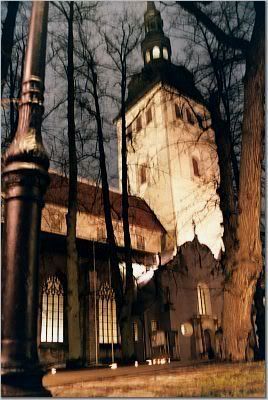
But getting back to Toompea hill; in the back of the castle area, behind the parliament, there are several overlooks with breathtaking views.
Here is a closer view of St. Nicholas' steeple...

Another view of Kiek in de Kök...

an area of town where old meets new...

Views of the Lower Town and the sea...


and here's me.

The tall pointy spire in back of these pictures belongs to St. Olaf's (or Oleviste) Church. St. Olaf's was the tallest building in the world in the 16th century, with its awe-inducing height of 521 feet. After a few lightning strikes, it was reduced to a more humble 405 feet. (For some comparison, the Sears Tower is 1,450 feet; the Eiffel Tower is 1,063...)
Here is a neck-craning view from the base...
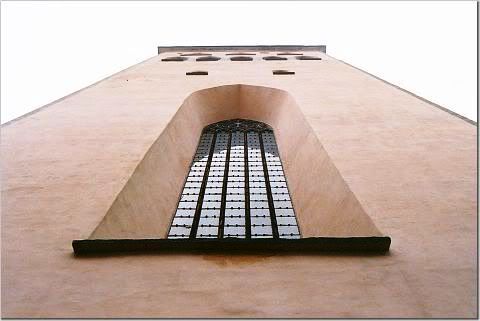
and the side of the church, with the top lost in a low-lying fog.

Near St. Olaf's are the Three Sisters, a trio of 14th century houses now interconnected to form a hotel. You may recall the Three Brothers from Riga; these are similar siblings.
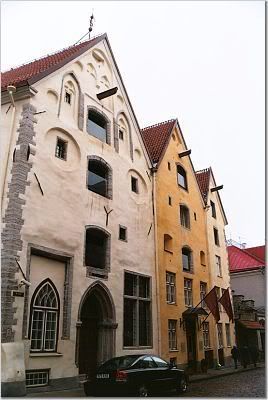
From the Three Sisters one can exit the city wall through the Great Coastal Gate and see Fat Margaret, another famous bastion intended as the first line of defense in an attack from the sea. Fat Margaret was built to house canons; with a diameter of 82 feet, a height of 65 feet and walls up to 18 feet thick you can see where it gets the name "fat."
Tower and gate...

view through the gate back into town.

Walking around the outside of the old town from the gate, you'll find the memorial commemorating the Estonian ferry tragedy. In 1994, the cruiser/ferry M/S Estonia, traveling from Tallinn to Stockholm, sank in rough weather, taking 852 people with it. The memorial in Tallinn comprises of two large metal arches with a gap inbetween, apparently symbolizing the failed completion of journey.
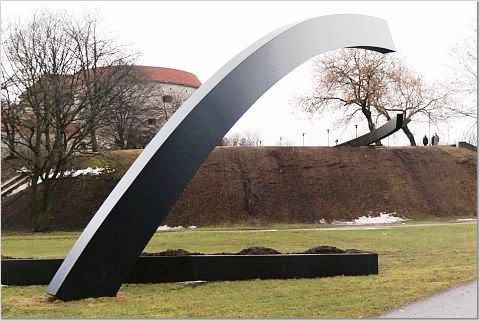
From here, we have the good fortune to complete OUR journey by re-entering Tallin from the east, through the Viru Gates.
Here are some outer sections of the town wall...
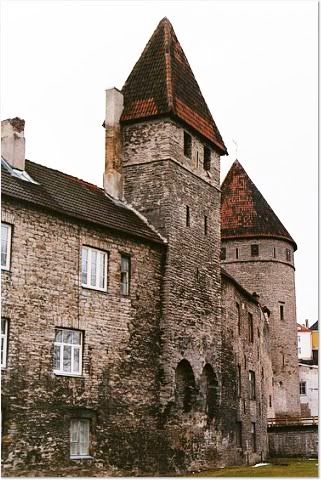
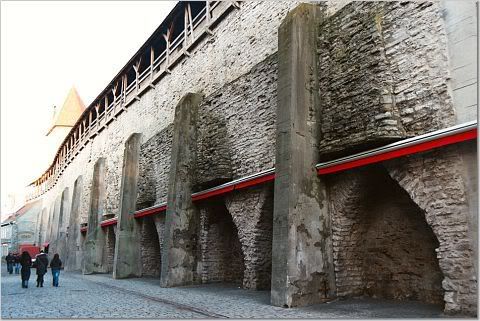
and last but not least, we come to the gates. I unfortunately missed getting pictures of them; I guess I was too distracted by the flower stands before them and the bustling shops once inside the city walls. Therefore, I present this google-found image of the Viru Gates by night.

Hope you've enjoyed this virtual stroll through another of the Baltic capitals; expect us to visit Vilnius in the future to complete the trifecta. And when we do, you can also expect it to be blogged about in a reasonable amount of time.
